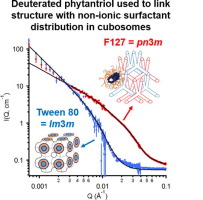Journal of Colloid and Interface Science ( IF 9.9 ) Pub Date : 2018-09-07 , DOI: 10.1016/j.jcis.2018.09.022 Nageshwar R. Yepuri , Andrew J. Clulow , Richard N. Prentice , Elliot P. Gilbert , Adrian Hawley , Shakila B. Rizwan , Ben J. Boyd , Tamim A. Darwish

|
Phytantriol is an interfacially-active lipid that is chemically robust, non-digestible and forms particles with internal bicontinuous cubic phase structures (cubosomes) when dispersed with non-ionic surfactants at ambient and physiological temperatures. The liquid crystalline internal structure of phytantriol-based cubosomes can be changed to alter the interfacial contact area/topology with the aqueous dispersant to trigger bioactive payload release or to alter the local membrane curvature around bound or embedded proteins. To enable the study of payload distribution, structure and transformation kinetics within phytantriol particles by neutron scattering techniques it is desirable to have access to a deuterated version of this molecule but to date a synthetic route has not been available. The first successful synthesis of phytantriol-d39 is presented here alongside a preliminary physical characterisation of related particle structures when phytantriol-d39 is dispersed using two non-ionic surfactants, Tween® 80 and Pluronic® F127. Synchrotron small angle X-ray scattering (SAXS) was used to confirm that phytantriol-d39-based nanoparticles in D2O form similar liquid crystalline structures to those of their natural isotopic abundance (phytantriol/H2O) counterparts as a function of temperature. Finally, small angle neutron scattering (SANS) with solvent contrast to match out the phytantriol-d39 structuring was used to show that the spatial correlations between the Tween® and Pluronic® non-ionic surfactant molecules are different within dispersed phytantriol-d39 particles with different liquid crystalline structures in D2O. The surfactant molecules in phytantriol-d39/Tween® 80 particles with Im3m cubic structures were found to follow a self-avoiding walk, whereas in phytantriol-d39/Pluronic® F127 particles with Pn3m cubic structures they were found to follow a more rod-like packing arrangement.
中文翻译:

氘代植物三醇–一种利用中子散射探测液晶脂质相中物质分布的通用化合物
苯丙三醇是一种界面活性脂质,具有化学稳健性,不易消化,并且在环境和生理温度下与非离子表面活性剂一起分散时,会形成具有内部双连续立方相结构(立方微粒)的颗粒。可以改变基于植物三醇的立体微粒的液晶内部结构,以改变与水性分散剂的界面接触面积/拓扑结构,从而触发生物活性有效载荷的释放或改变结合或嵌入的蛋白质周围的局部膜曲率。为了通过中子散射技术研究植丹三醇颗粒内的有效负载分布,结构和转化动力学,希望能够获得该分子的氘代形式,但迄今为止尚无合成途径。首次成功合成植物三醇-d 39是此处提供的旁边相关粒子结构的初步物理表征时phytantriol- d 39使用两个非离子表面活性剂,80和普朗尼克F127被分散。同步加速器小角X射线散射(SAXS)用于确认D 2 O中基于植物三醇-d 39的纳米颗粒形成的液晶结构与其天然同位素丰度(植物三醇/ H 2 O)对应物的液晶结构类似,取决于温度。最终,小角度中子散射(SANS)和溶剂对比使植丹三醇-d 39相匹配结构化表明,Tween®和Pluronic®非离子表面活性剂分子在D 2 O中具有不同液晶结构的分散的phytantriol- d 39颗粒之间的空间相关性是不同的。phytantriol- d 39 / Tween中的表面活性剂分子发现具有Im 3 m立方结构的®80颗粒会自动回避,而具有Pn 3 m立方结构的phytantriold d 39 / P127(F127)F127颗粒则发现遵循更棒的堆积方式。


























 京公网安备 11010802027423号
京公网安备 11010802027423号